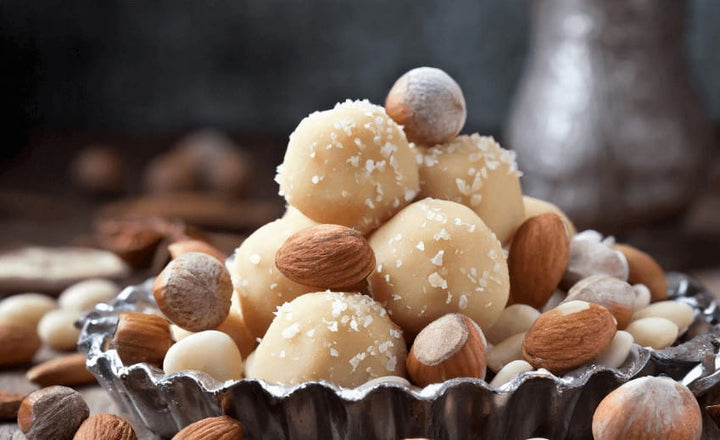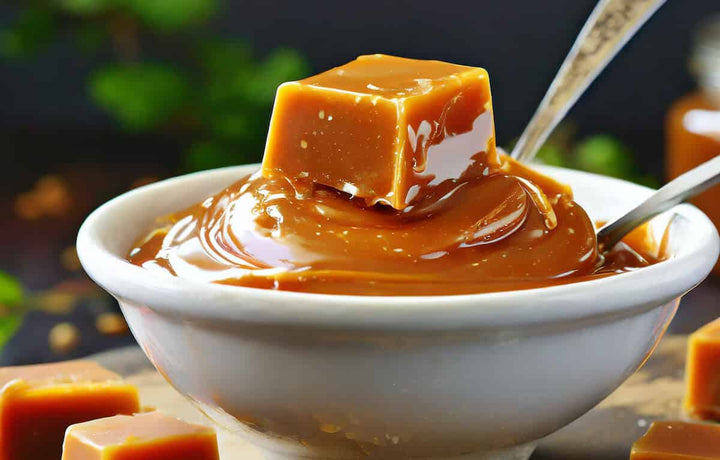Marzipan, a confection that dances on the palate with its sweet, nutty essence, holds a storied place in the culinary traditions of many cultures.
This versatile treat, made primarily from sugar or honey and ground almonds, has a smooth, pliable texture that allows it to be easily moulded into various shapes or used as a covering for cakes, making it a favourite among bakers and confectioners alike.
Its origins, steeped in history, span continents and centuries, reflecting the global journey of almonds and sugar through trade routes and royal courts.
This post looks into the rich tapestry of marzipan's history, its uses in baking and confectionery, and the artistry of crafting it.
What is Marzipan?
Marzipan is a confection primarily made from ground almonds and sugar or honey, known for its smooth, dough-like texture and sweet, nutty flavour.
This versatile mixture can be easily coloured and moulded into various shapes, making it popular for crafting decorative sweets and as a covering or filling in cakes and pastries.
The ratio of almonds to sugar varies, influencing the texture and taste—higher almond content results in a softer, more nuanced flavour, while more sugar creates a sweeter, firmer product.
Originating from a rich culinary tradition, marzipan's history is as layered as its uses in baking.
It is believed to have Middle Eastern roots, with its popularity spreading to Europe through trade and conquest, where different cultures adopted and adapted it.
Today, marzipan is celebrated in many parts of the world, especially in Europe, where it is a staple in holiday treats and wedding confections, as well as in the Middle East and Asia.
In addition to its use in decorative and celebratory foods, marzipan also holds a special place in the art of confectionery.
Skilled artisans shape it into fruits, animals, and miniature figures, showcasing its malleable nature and the creative potential it offers.
Related Post: Discover Authentic Turkish Delight

What Does Marzipan Taste Like?
Marzipan has a distinctive, sweet taste with a rich almond flavour that is both subtle and nuanced.
The exact taste can vary depending on the ratio of almonds to sugar and the addition of any flavourings, such as rose water or almond extract, which are sometimes used to enhance their flavour profile.
At its core, marzipan is characterised by its smooth, slightly granular texture that melts in the mouth, offering a luxurious mouthfeel.
The sweetness of the sugar balances the natural nuttiness of the almonds, creating a harmonious blend that is not overly sweet but pleasantly rich.
High-quality marzipan, which contains a higher percentage of almonds, tends to have a more refined and less sugary taste, allowing the delicate almond flavour to shine.
This makes it a versatile ingredient in baking and confectionery, complementing various flavours from fruits to chocolate..
How to Make Marzipan
Making marzipan at home is a delightful and straightforward process that allows you to control the quality and flavour of the final product.
Here's a basic recipe to create your own marzipan:
Ingredients:
- 250 grams of ground almonds (almond meal or almond flour)
- 250 grams of icing sugar (powdered sugar), plus extra for dusting
- 2 medium egg whites
- 1 teaspoon of almond extract (optional for enhanced flavour)
- 1 teaspoon of lemon juice or rose water (optional, for flavour)
Instructions:
-
Prepare the Ingredients: Sift the icing sugar into a large mixing bowl to remove lumps. Add the ground almonds to the bowl and mix them together.
-
Mix Wet Ingredients: Lightly beat the egg whites until frothy in a separate bowl. Add the almond extract and lemon juice or rose water if using. These add a subtle depth to the marzipan's flavour.
-
Combine: Gradually add the wet and dry ingredients until thoroughly combined. You can start with a spoon and then use your hands to ensure the mixture is well-blended.
-
Knead the Marzipan: Dust a clean surface with icing sugar. Turn out the marzipan mixture and knead it gently until it forms a smooth, pliable dough. If the mixture is too sticky, add more icing sugar until you achieve consistency.
-
Rest the Marzipan: Wrap the marzipan in cling film (plastic wrap) and let it rest in the fridge for at least a few hours. This resting period allows the flavours to meld together and the marzipan to firm up, making it easier to work with.
-
Use or Store: After resting, your marzipan is ready to use. It can be rolled out to cover cakes, shaped into figures, or used as an ingredient in other desserts. If not using immediately, you can store marzipan in an airtight container in the fridge for up to a month.
Notes:
- Egg White Alternative: For those concerned about raw egg whites, pasteurised egg whites or a few tablespoons of corn syrup can be used as alternatives. These ingredients help bind the marzipan without the need for raw eggs.
- Flavour Adjustments: Feel free to adjust the amount of almond extract or lemon juice/rose water to suit your taste preferences.
Homemade marzipan has a fresh, natural taste that surpasses most store-bought versions.

What is Marzipan Used For?
Marzipan is a versatile confection with various uses in the culinary world, celebrated for its sweet almond flavour and pliable texture. Here are some of the primary ways marzipan is used:
1. Cake Decorating and Covering:
Marzipan is often used to cover cakes, providing a smooth surface for icing or fondant.
It's particularly popular for traditional wedding and Christmas cakes, which act as a base layer beneath royal icing, enhancing the cake's appearance and taste.
2. Sculpting and Modelling:
Due to its pliable nature, marzipan can be easily moulded into shapes and figures, making it a favourite for creating intricate cake decorations, such as fruits, animals, and flowers.
These edible decorations add a touch of elegance and fun to cakes and desserts.
3. Confectionery:
Marzipan is used to make a variety of sweets and treats.
It can be formed into small balls, coated with chocolate, or cut into shapes and decorated with icing to make marzipan fruits, especially popular during the holiday season.
4. Baking Ingredient:
Marzipan can be incorporated into baked goods as a filling or an ingredient in the batter.
It's used in pastries such as stollen, a traditional German Christmas bread, and almond croissants.
It adds a moist, dense texture to cakes and a rich almond flavour.
5. Chocolate Filling:
Marzipan pairs beautifully with chocolate and is often used to fill luxury chocolates and chocolate bars.
Combining the sweet, nutty marzipan with the bitterness of dark chocolate or the creaminess of milk chocolate creates a delightful taste experience.
6. Dessert Component:
Marzipan can also be served as a standalone dessert, often shaped into logs and sliced, or used as a component in more complex desserts, adding texture and flavour.
7. Festive Treats:
Marzipan is a traditional treat for various holidays and celebrations in many cultures.
For example, it's moulded into shapes such as pigs for New Year's in some European countries or used in simnel cake during Easter.

How is Marzipan Made?
Commercial marzipan production involves a refined process to ensure consistent quality and flavour.
It starts with blanching almonds to remove skins, then grinding them into a fine paste, sometimes with added almond oil for flavour and texture.
The paste is then mixed with sugar or syrup, cooked in specialized kettles to dissolve the sugar and sterilize the mixture, and potentially conched to refine texture and flavour.
After cooling and kneading to achieve smoothness, the marzipan is shaped, packaged, and undergoes quality control to ensure it meets high standards.
This process blends traditional recipes with modern techniques, allowing mass production of marzipan while maintaining its characteristic taste and texture.
Marzipan vs Almond Paste - What’s the Difference?
Marzipan and almond paste are made from ground almonds and sugar but differ mainly in texture, sweetness, and use.
Almond paste is coarser, less sweet, and used as a filling in baked goods.
Marzipan is smoother, sweeter, and often used for decorative purposes in confectionery, such as cake covering and sculpting.
Where Can You Buy Tasty Chocolate?
Whitakers Chocolates, renowned for our long history in crafting delicious and affordable chocolates, offers a range of options suitable for everyone, including vegetarian, vegan, and gluten-free choices.
Our top-selling products, such as indulgent Coffee Creams, Neapolitans, Chocolate Wafer Thins, Stem Ginger and Luxury Chocolate Truffles, are perfect for enhancing your mocha coffee experience.
Click here to see our full range of delicious chocolates…
Some Notes From an Expert Chocolatier
Marzipan, with its rich almond flavour and malleable texture, offers a delightful contrast to chocolate's smooth, deep notes.
Adding marzipan allows various flavours to elevate a simple treat into a gourmet experience.
The key to successfully combining these elements lies in balance and quality.
Using high-quality marzipan ensures a smooth, refined almond taste and allows for precise shaping and detailing, which is crucial in confectionery art.
The sweetness of marzipan complements the bitterness of dark chocolate beautifully, while milk or white chocolate can highlight its nutty undertones.
Experimenting with these combinations, I've discovered that marzipan can be a versatile ally in chocolate making.
It can be infused with natural flavourings, colours, or even liqueurs to introduce new dimensions to chocolate.
Final Notes On Marzipan
Marzipan stands as a testament to the artistry and tradition of confectionery.
This blend of ground almonds and sugar, often enriched with honey or almond extract, embodies a rich culinary heritage that spans continents and centuries.
Its smooth, pliable texture and sweet, nuanced flavour make marzipan a favourite among bakers and confectioners for its versatility in decoration and flavour enhancement.
From its origins in the Middle East to its widespread popularity across Europe and beyond, marzipan has been cherished for its ability to be moulded into intricate shapes, cover cakes with a seamless layer, and add depth to an array of desserts.











